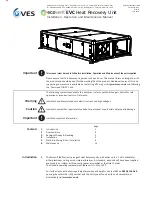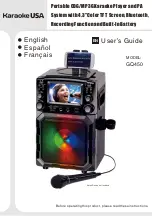
Installation and user guide- 21
o
The alarm will not operate if the water in the probe is frozen or the surface of the
pool is frozen.
o
If the alarm is in off mode, the alarm will not sound.
o
If the alarm is in attenuated mode, the alarm sound will be quieter than usual and
may not be heard.
o
The proper performance of TRITON™ is not correctly achieved if used in parallel
with tarpaulins.
•
The alarm does not rescue children from the water. When the alarm sounds, a
rescuer must respond immediately – a child rescued in less than 1 minute has a good
chance of survival, but the odds of surviving rapidly decline the longer the child is
immersed. To increase the chance of rescuing a child who enters the pool, a responsible
adult capable of rescuing a child must be present, able to hear the alarm, and ready to
respond immediately. Even an immediate response when the alarm sounds does not
guarantee survival; the only sure way to prevent drowning is to keep children out of the
pool.
•
The alarm does not prevent children from entering the pool. Use adult supervision
and barriers, such as fences, enclosures, or pool covers, to keep children from entering
the pool.
•
This device is not intended to replace any other safety consideration: that is, adult
supervision, lifeguards, fences, gates, pool covers, locks, and so forth, and some devices
may not detect gradual entry. This device may not detect children entering the water
gradually.
•
Check local requirements to determine the safety measures that are required in
your jurisdiction. Consider using multiple layers of protection, in addition to adult
supervision and this pool alarm, DO keep children away from the pool or alert adults to
their presence. For more information, contact the Association of Pool and Spa
Professionals (
www.TheAPSP.org
).
•
This alarm does not replace responsible adult supervision.
•
Whenever children are in an area where they have access to the pool:
o
Assign an adult to be in charge of watching the children. This person must stay
close to the children and actively look at what the children are doing at all times.
Make sure that the adult is aware of his responsibility and that if he leaves, he
must ask another adult to take over.
o
Make sure the adult, in charge of watching the children, is able to swim in order to
rescue the victim and is able to call for emergency assistance. The adult should
understand how the alarm works and know not to rely on the alarm in place of
actively watching the children.
o
If there are many children nearby the pool, it may be necessary to assign multiple
adults to watch them.
o
When the alarm is INACTIVE DETECTION to allow swimming, it will not sound if a
child enters the pool or if a child is drowning, so adult supervision is particularly
important.
•
When children are not in an area where they have access to the pool:
o
Make sure that adults understand that they must keep children away from the
pool, even with the alarm in place.
o
Make sure any adult who uses the pool understands how to operate the alarm,
and that they must monitor the pool after swimming until the alarm returns to
DETECTION mode.
GENERAL SWIMMING POOL SAFETY TIPS
•
Teach children how to swim as early as possible. Never leave a child who can not swim yet
unattended close to the pool. Consider putting Personal Flotation Devices (PFDs) on children
who can not swim properly.
•
Learn first aid and CPR.
•
Prohibit diving and jumping when small children are in the pool. Prohibit running and playing
around the pool.




































